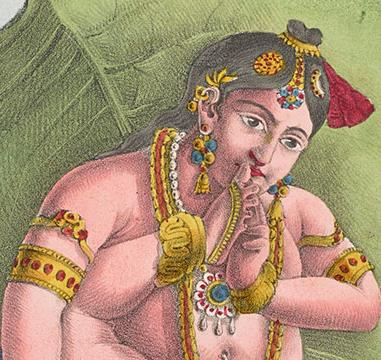Smithsonian Exhibition Traces European and American Fascination with Indian Devotion
“Strange and Wondrous: Prints of India From the Robert J. Del Bontà Collection,” on view Oct. 19–Jan. 5, 2014, at the Smithsonian’s Arthur M. Sackler Gallery, presents 50 printed works that trace European and American documentation of Indian ascetics, deities and religious ceremony.
As global travel boomed from the 16th to the 20th century, Europeans and Americans became increasingly fascinated with Indian culture. Merchants, missionaries and soldiers alike documented their encounters in India and foreign lands through detailed texts and illustrations. These accounts—regularly edited, amended and reprinted in publications as varied as atlases, trading cards, memoirs and magazines—became the paradigm for all that Europeans and Americans found strange, exotic, repulsive or remarkable in India.
Created using a wide variety of techniques, such as engraving, aquatint, lithography and photogravure, these prints demonstrate how perceptions of Indian culture shifted through the centuries, from the European Enlightenment to the period of colonial expansion and into modernity.
“As a collector, Del Bontà not only pays immense attention to the subjects that captivated Europeans and Americans, but also to the multiple versions of popular prints as they travelled across countries, languages and time,” said Holly Shaffer, guest curator and Yale University doctoral candidate. “His collection allows scholars to trace how Europeans and Americans learned about India, and reminds us to always question the ‘truth-value’ of images that often have a very long train to their visual history.”
The spread of images represented in “Strange and Wondrous” led to broader knowledge and interest in Indian culture—but also to the creation and proliferation of negative stereotypes. Ascetics, or religious figures (often termed “yogis and “fakirs”), with their otherworldly, naked appearance and austere practices, were depicted as supernatural beings, devout penitents, militants, tricksters and beggars. Religious ceremonies, such as swinging from hooks (charak puja), were often interpreted in a Christian framework, rather than a Hindu one, leading to misconceptions of devotees as sinners and fanatics. Deities such as the Hindu god Shiva were cataloged as lovers and drug users feeding generalizations of India as a sensual, spiritual land.
American publications added another layer of satire to their interpretation of exotic cultural practices. A 1943 cover of the Saturday Evening Post illustrated by Norman Rockwell shows the beloved World War II character Willie Gillis outwitting an Indian ascetic with the children’s game “cat’s cradle,” a visual pun of the infamous “Indian rope trick.” Here an American GI has duped the once-powerful Indian yogi, and while it is perhaps a nod to American soldiers’ wily abilities during wartime, the stereotype of India remains intact.
“Strange and Wondrous” will be on view in conjunction with “Yoga: The Art of Transformation”—the world’s first exhibition on the art of yoga—which also opens Oct. 19 at the Sackler Gallery.
The 50 works on view in “Strange and Wondrous” are part of Del Bontà’s bequest of 100 printed works to the Freer and Sackler archives. The collection will be a resource for scholars and educators to evaluate and understand early European and American perspectives of Indian culture through print.
Del Bontà—a polymath scholar, curator, collector and jeweler—began to collect prints related to India while completing his doctorate in South Asian art history at the University of Michigan in the 1970s. His extensive collection includes more than 2,000 loose prints and thousands more bound within books, spanning genres from Indian calendar prints, ephemera, painting and sculpture to British Raj-era publications and subjects such as ornament, flora and fauna, Indian ascetics, deities and religious ceremony.
Visitors can learn more about the layers of fact and fiction in “Strange and Wondrous” through a conversation with Del Bontà, Shaffer and Freer and Sackler curator Debra Diamond Saturday, Oct. 19, at 2 p.m. Part of the series “Articulations,”the conversation will reveal Del Bontà’s collecting process, the relationship between prints and technology and popular perceptions of India.
The Arthur M. Sackler Gallery, located at 1050 Independence Ave. S.W., and the adjacent Freer Gallery of Art, located at 12th Street and Independence Avenue S.W., are on the National Mall in Washington, D.C. Hours are 10 a.m. to 5:30 p.m. every day (closed Dec. 25), and admission is free. The galleries are located near the Smithsonian Metrorail station on the Blue and Orange lines. For more information about the Freer and Sackler galleries and their exhibitions, programs and other public events, visit www.asia.si.edu. For general Smithsonian information, call (202) 633-1000.
# # #
SI-382-2013

